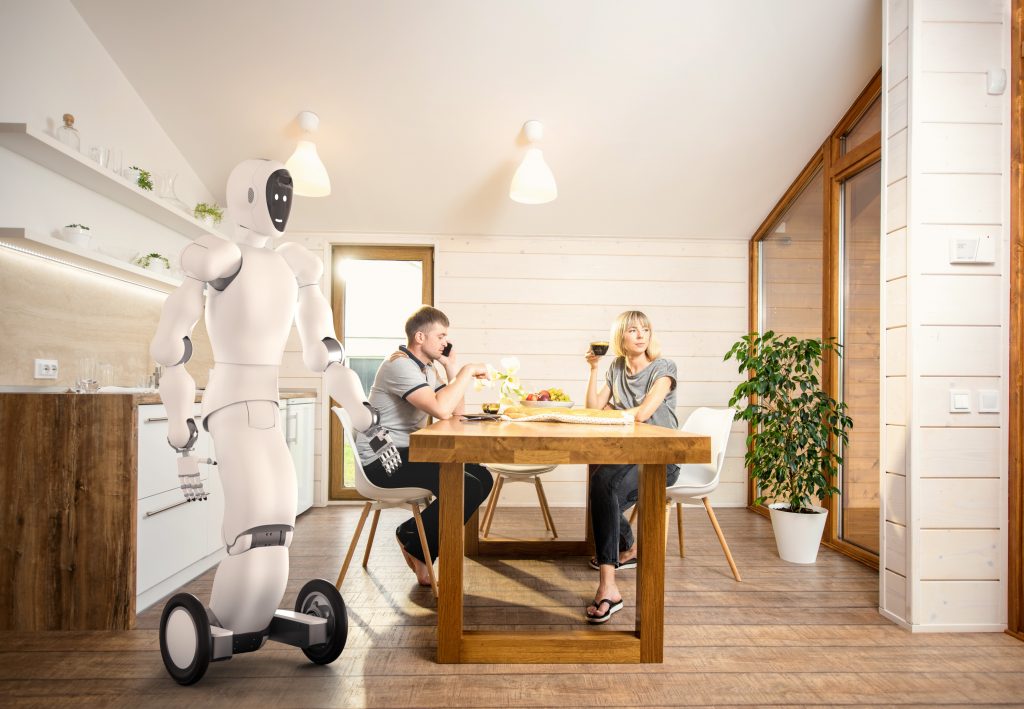
Fingers grip a kettle’s handle and pour you a perfect cup of coffee. Then, they lift a suitcase, open a door and hand you a bottle of water. But this is no human assistant – under its sleek, white aluminum and plastic body, wheels shuttle this social robot to its next task. Its manipulating, gripping hands are innovative for robots.
You can manage this next-gen robot’s controls using virtual reality (VR.) The human behind these movements can be close or miles away.
Humanoid robot EVE performs motions and actions useful in human settings.
From the video promo for next-gen humanoid robot EVE, it’s clear manufacturer Halodi Robotics of Norway wants to change the fast-moving robotics industry.
Designing robots for human lives
Halodi believes robots should fit into our lives and spaces, not the other way around. Factories and facilities must often be redesigned to accommodate, for example, robots that help transport heavy items.
Fascinated?
Follow innovation
Secure Futures keeps you on the cutting
During our recent interview, Halodi’s CEO Bernt Øivind Børnich said the company wanted to explore a different route.
Launched in early 2020, the first version of EVE is designed to work with people with mobility issues or patrol areas unsafe for human guards, like nuclear waste sites or places with inhospitable weather.
“We want to build robots that are safe, capable and affordable,” says Børnich. “They can patrol autonomously without much human intervention. If a situation comes up, the owner can take control using a VR headset, rather than send in a human to do a dangerous task.”
To control an EVE robot, you simply strap on the VR headset. EVE then imitates your movements and when you speak, relays your words in its own voice.
All about robot EVE
EVE is around the average height of an NFL player (6 foot 1 inches or 1.86 m,) but rather lighter at 174 pounds (less than 80 kg.) It can lift 17 pounds (8 kg) per arm and zips along at speeds of up to 14 miles (22 km) per hour. Cameras linked to Intel CPUs act as sensors that let EVE navigate its environment, whether in a home or traversing rough terrain outside a nuclear plant.
EVE’s face was designed to look like a robot, rather than human, face. Børnich says he was inspired by the 2008 Pixar and Disney film Wall-E: “Those eyebrows can express so much emotion, and we didn’t want the robot to look too much like a human.” He’s no doubt aware of the ‘uncanny valley’ where people find robots creepy when their appearance is too human-like.

Layered with AI, EVE can understand more human commands over time, as Halodi keeps feeding the software more data. So, in a home setting, someone could say, “bring me a bottle of water” and EVE will understand the command without any controller needed.
EVE has been deployed for testing at the Toyota Research Institute in California, which specializes in nuclear research. A university in Norway is using the robot for research and teaching next-gen robotics.
Børnich explains the next phase will bring another iteration of EVE to more pilot trials for commercial applications, including retail, in 2021.
“Robots controlled by VR open many possibilities,” said Darrell West, author of The future of work: Robots, AI and automation, when I interviewed him. “If they can help humans can avoid dangerous places, like minefields and extreme weather events, they can live up to the buzz.”
VR-controlled robots aren’t new, as ABI Research analyst Rian Whitton said when I spoke to her. Notably, medical robotics let surgeons to remotely operate on patients using VR. “The more impressive innovations we’ve seen are in navigation [of rough terrain,] and the software stack to allow robots to work more autonomously,” he adds.
DaVinci robot controlled by a surgeon using toggles and buttons.
Where to next for robotics?
Here’s the thing: robots controlled with VR aren’t often in the public eye beyond healthcare and manufacturing. EVE could invite more innovations riffing of the theme of connecting these robots with more widespread applications.
As Whitton noted in my interview with him, Halodi’s market space is increasingly competitive and lucrative. Major players from the US, China and Europe are all vying for a piece of the 32 billion US dollar robotics industry, according to the 2020 estimates of robotics researchers ABI Research.
Børnich contends what will separate winners from the ‘also ran’ manufacturers are general purpose robots. “The more tasks you can solve with one platform, the better positioned you are to bring more value to your customers. Look at smartphones: Before they came around, we had separate devices for GPS tech, telling the time, managing our schedules, and so on. Once you can put all that into one device and bring the cost down, everyone finds that new technology useful. It’s the same with robotics.”
As progress in robotics accelerates, forward-thinking businesses shouldn’t twiddle their thumbs on the sidelines. They should use the advancements these new technologies bring to healthcare, supply chains and everyday life. When opportunity knocks, the door should open as fast as possible.




